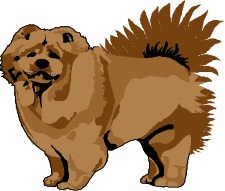How To Teach Two Dogs
|

|
Whether you have two of the same breed to two (or more) different breeds, it's tough to walk more than one dog at a time. They often go in opposite directions, play and become entangled in their leashes, or behave in a territorial manner when confronted with other dogs.
Not only is teaching your dogs to walk together helping you, it also helps them. When the dogs are having difficulties acknowledging hierarchical positions, brace training is the best means of teaching them to defer leadership to you and learn to work and be close to each other without brawling.
|

|
The best place to begin is with teaching both dogs individually, how to perform their basic commands of heel, sit, stay, down and come. They must be at least 80% responsive to these commands before you can expect them to listen to them while in close contact with each other.
There are three levels to brace training. During level one you will be holding their leashes in different hands, while both dogs are working on your left. The dog working on the inside, closest to you, is held in your right hand, while the leash of the dog on the outside is held in your left hand. Be sure the outside dog's leash comes behind the head of the inside dog and does not hit him in the face. The dogs are not attached to each other.
In level two, the dogs are attached to each other via a brace connector, yet you still hold your leashes in opposite hands. At this time the dogs are learning to complement each other's movements, yet you still have control of them as individuals.
Level three takes a long time to reach. At this level, one leash is placed in the center ring of the brace connector, with no individual control over the dogs. They should be very attentive and working consistently before this level is attempted.
Before starting, come up with a tandem name to use for both dogs, such as Dogs, Guys, Girls, Boys, Babies, Puppies. You get the idea. Using a tandem name will help keep the dogs from losing their individual identities. The only times you'll use their individual names is before a correction, so the dog being corrected knows that the low tone is directed at him and will decrease the other dog's chance of feeling guilty when not misbehaving.
Another suggestion. The outside dog should be a faster mover than the inside dog. If both tend to move out at the same speed, then the more dominant dog should be the inside dog. Maintain their same positions throughout their training session.
Begin by lining both dogs up in a sit. Go to their right shoulders, put the outside dog's leash in your right hand and the inside dog's leash in your left hand. Step forward on your left leg as you say, "Dogs, Heel." in a demanding, but not loud, tone of voice. Step forward on your left leg, just as you would when working with one dog. Consistency is needed when crossing over from working one to working two. (Your dog should already know his visual cues that work with the vocal commands.)
The tricky part of heeling with two dogs is correcting their position, especially when one is out of place and the other is not. Here are a few scenarios and how to correct them:
Scenario #1: The outside dog is forging ahead.
Do a quick right about turn as you say that dog's name before the reprimand word. Be sure to give a tug only on the leash of that dog, which would be held in your left hand.
Scenario #2: The inside dog is forging ahead.
Do a quick right about turn, preferably a 180 degree. Coax the dogs to catch up.
Scenario #3: The outside dog is pushing the inside dog either into you or making it fall behind you. Tug the outside dog's leash away from you which will allow more space for the inside dog.
Scenario #4: The dogs are playing with each other. Both dogs should be corrected by tugging and releasing while saying, "Dogs, No!" in a low tone of voice.
Scenario #5: Both dogs are heeling wide. Do a 90 degree right turn, while tugging leash and saying, "Dogs, No!"
Scenario #6: The inside dog or both dogs are a little bit ahead, i.e. their middles are even with your left leg instead of their head to shoulder region.
Do a 90 degree turn to the left.
Try to keep moving quickly. You will keep your dogs (and your wits) together far better if you continue moving, then if you stop and try to disentangle the dogs. Do not allow the dogs to stop and sniff or play with one another. If they start to look at a distraction, turn in the opposite direction, quickly.
Good Luck!
Tips Archives




